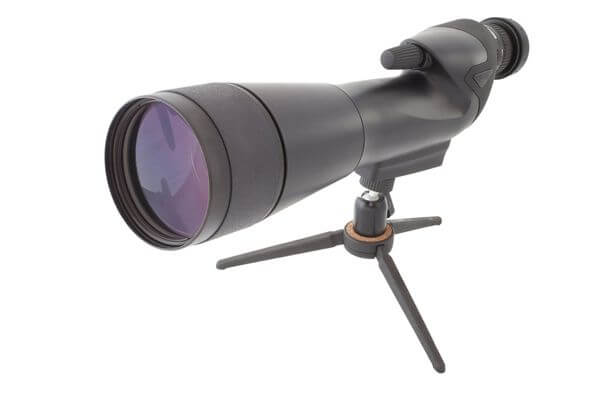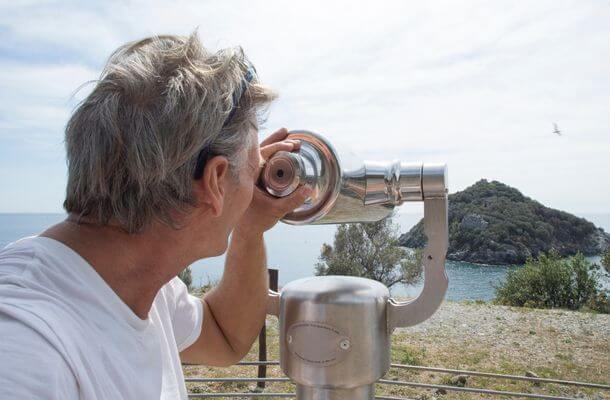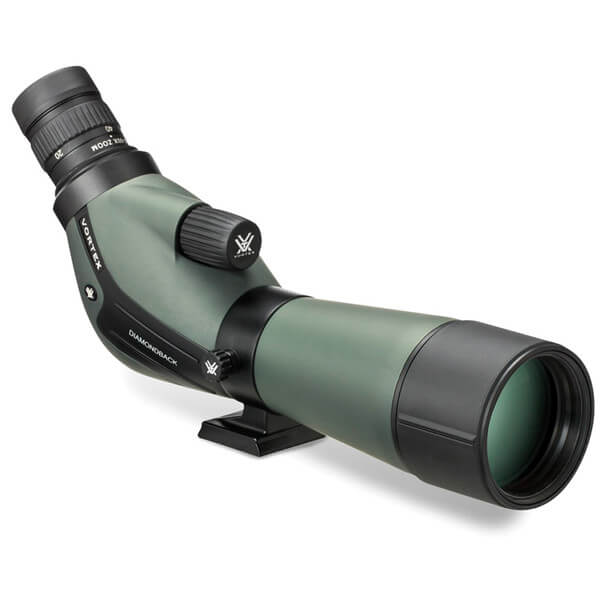This site contains affiliate links. As an Amazon Associate, I earn a commission from qualifying purchases at no extra cost to you. Full Disclosure Here.
Spotting scopes are an essential part of long-range shooting, whether you’re punching paper or out on the plains somewhere going after game at long ranges.
Today we’re going to go over the best spotting scopes for 1000 yards and beyond, so you can find the perfect one for your next long-range shooting adventure.
Let’s dive right into some reviews of the best models. Then we’ll talk about how to choose the best one to meet your specific needs, whether you’re searching for game in the canyonlands or tracking hits on steel or paper at a PRS competition or anything in between.
Also Read: 16 Best Spotting Scopes in 2022
Best Spotting Scopes for 1000 Yards
Vortex Optics Diamondback 20-60X80 Spotting Scope – Overall Favorite
My overall favorite spotting scope is the Vortex Optics Diamondback 20-60X80 Spotting Scope. It’s a great option that balances features in price to give you a great scope and a great value.
For starters, it delivers excellent optics thanks to a Porro prism, XR fully multicoated lenses, and dielectric coatings on the lenses. There’s also a built-in sunshade to help reduce glare and protect the objective lens from precipitation like rain or snow.
The eyecups are adjustable for more comfortable viewing, and the Diamondback is available in both straight and angled versions. A rotating tripod ring allows you to adjust your viewing angle easily.
Finally, this spotting scope is both waterproof and fog proof, thanks to o-ring seals and nitrogen gas purging. Like all Vortex products, it’s protected by Vortex’s VIP Lifetime Warranty, which covers defects and accidental damage.
It comes with an eyepiece cap, an objective lens cover to protect your lenses while not in use, and a view-through carry case.
Pros
- Porro prism
- Fully multi-coated optics
- Waterproof and fog proof
- Vortex VIP warranty
- It comes with lens covers and a carry case
Cons
- The image becomes less clearly at higher magnification strengths
Celestron Ultima 20-60x80mm Spotting Scope – Best Budget
There are a lot of really expensive spotting scopes out there, but not having a huge budget doesn’t mean you can’t still get a good spotting scope. At a sub-$200 price point, the Celestron Ultimata 20-60x80mm spotting scope provides a decent quality spotting scope without emptying your wallet.
Unlike many budget scopes, the lenses are fully multicoated, not just multicoated. The scope is waterproof and fog proof, not just water resistant.
Obviously, you don’t get the same optical quality you’d expect from a more expensive spotting scope, but it’s not bad, either. It’s primarily designed for astronomical use, and the optical quality reflects that.
However, you could definitely use it for casual range days or hunts. I recommend it for shooters new to spotting scopes because it’s effortless to use.
Weighing 57 ounces, it’s on the low end for spotting scope weights without feeling flimsy, so it’s easy to carry into the field. Be careful packing it, though, because while it comes with a case, the case is soft-sided.
Pros
- Extremely affordable
- Great for beginners
- Fully multicoated optics
- Waterproof and fog proof
- It comes with a carry case
Cons
- Some chromatic aberration, starting around 35x and increasing with higher magnification.
- It doesn’t come with a hard case.
Vortex Optics Razor HD 27-60X85 Spotting Scope – Best High End
On the opposite end of the price spectrum is the Vortex Optics Razor HD 27-60X85 Spotting Scope. This is the one for you if you’re looking for a spotting scope with all the bells and whistles.
The Razor HD gives you an incredibly clear picture out to 1,000 yards and even beyond, regardless of magnification setting, giving you no problem seeing heat waves and other essential details.
This Porro prism scope boasts index-matched lenses made from extra-low dispersion glass to provide hard-to-beat image definition and color fidelity. The lenses are fully multicoated with XR Plus lens coatings on all air-to-glass surfaces to improve light transmission and picture clarity. The lens coatings are even applied using a special Plasma Tech process to enhance their performance and durability.
For durability, the Razor HD is argon-purged to eliminate fogging, and O-ring sealed to keep moisture and debris from entering the scope, making it waterproof. It also features ArmorTek scratch-resisting coatings to protect the lenses from debris.
Pros
- Ultra high-quality lenses
- Plasma Tech lens coating application
- Scratch-resistant lenses
- Waterproof and fog proof
Cons
- Pricey
- I would have liked to have seen a wider magnification range.
BARSKA Blackhawk 20-60X60 Spotting Scope – Most Lightweight
If you’re going to be trekking over rough terrain for long distances, or you just want to keep your pack weight down as much as possible, then the BARSKA Blackhawk is a great option for you. This angled spotting scope goes up to 60x magnification, which is incredible for the price.
The glass is extremely clear and color accurate, though we noticed more glare with the sunshade down than we saw with other models. That’s why it has an extendable sunshade built in.
Light-gathering late in the afternoon and in the pre-dawn gloom was also excellent, and the whole scope body is rubber armored as well as water and fog proof, making this a great one for those long days with changing temperatures as the day wears on.
Lastly, the included accessories are a lovely addition, especially for the price point, and have both a hard case and a soft case so you can store and transport your scope without worrying about it getting damaged en route.
There is also a compact little tripod included that, while not the best, is certainly more than sufficient for spotting on a bench rest, which is something a scope like this excels at. If you’re spotting any kind of shooting with a bench or table to work with, this kit is ready to go out of the box.
Pros
- Lightest weight scope on this list
- Extra-rugged armor keeps it safe in a backpack or range bag
- Comes with soft and hard cases for storage and transport
Cons
- Color accuracy isn’t the best
- Poor low-light performance compared to higher-end options.
Vortex Optics Viper HD 20-60X85 Spotting Scope – Best for Low Light
If you want to step up a bit from our top overall pick without going all the way to the Razor model, especially if you’re a hunter, then the Vortex Viper HD 20-60×85 is an excellent option for you.
This is one of the best scopes we’ve tested regarding light-gathering capabilities, and it’s the best in its price category. It’s one of the brightest spotting scopes you can get, which can make a huge difference when it’s getting late in the day, and you’re trying to ID a target at long range.
The glass is exceptionally crisp and clear, with anti-reflective and low-light coatings and an abrasion-resistant finish that is applied to keep the lenses safe from dirt and anything else that might want to scratch them.
Lastly, this is one of the most adjustable and ergonomic options on this list, from the adjustable eyecup to the flexible viewing angle, you’re sure to be able to find something that works for you. It also has an extendable sunshade to help you fight glare, protecting the large objective lens from rain, scratches, and fingerprints.
Pros
- Excellent light-gathering capability
- Ultra-rugged construction
- Best-in-industry lifetime warranty
Cons
- Focus adjustment on our test model was a little bit fussy.
Celestron Regal M2 80ED Spotting Scope
Next up, we have another Celestron option, the Regal M2 80ED. This one is primarily designed for bird watching, and digiscoping, so special attention has been paid to the color fidelity and accuracy.
The glass is extremely high quality with ultra-low dispersion and XLT coatings to maximize light transmission and minimize glare. If you’re a hunter and want to make sure you can spot a brown deer against a slightly different-brown background.
The eyepiece focus was crisp and reliable, with no mushiness or feelings of having the focus “slip” as you adjust it. The 20-60x zoom is perfect for everything from hunting to competition shooting.
Finally, the whole thing is armored and gas-purged, so it’s as drop-proof and fog-proof as any optic on this list.
Pros
- Incredible true-to-life color accuracy, even at long ranges
- Includes lens covers, storage case, and an adapter for mounting a DSLR
Cons
- A little expensive compared to other models
Pentax PF-80 ED 25-50X80 Spotting Scope
Pentax is a relatively lesser-known brand in the world of optics, and that’s a shame because everything I’ve used from them has been high-quality. As the name suggests, the PF080ED is an angled spotting scope with an 80mm lens (by default).
It is also available in 65mm and 100mm objectives, so you can step down if you’re mainly doing daytime spotting and want something lighter in weight, or you can step up to the vast 100mm objective lens if you’re doing a lot of low-light glassing of fields and spotting targets at dusk.
It’s also surprisingly lightweight overall, thanks to a primarily magnesium-alloy body. The glass is extra-low dispersion with special coatings to help draw in light and beat glare. Lastly, the whole thing is nitrogen purged and o-ring sealed, so it is fog proof and JIS Class 6 waterproof.
Pros
- 100mm Objective available
- Very lightweight for size and zoom level
- Excellent glass
Cons
- Relatively narrow magnification range
- It doesn’t include eyepiece
Nikon Prostaff 5 Proscope 20-60X82mm Angled Spotting Scope
It wouldn’t be a respectable list of scopes of almost any kind without at least one entry from Nikon on it, and it just so happens that Nikon makes an excellent spotting scope: the Prostaff 5.
The Prostaff line is one of Nikon’s most popular, especially with hunters, and with good reason. The whole line offers an excellent value-to-performance ratio, and the Prostaff 5 spotting scope here is no different.
It has fully multi-coated lenses that are ground precisely for this scope, and they aren’t generic lenses sourced from a manufacturer. The color fidelity is very high, almost perfect to my eyes, and the contrast is excellent even in low light conditions.
Like most spotting scopes designed for field conditions, the scope is O-ring sealed and gas-purged (with nitrogen) to keep it water and fog-proof even in changing temperatures. There is also a built-in adjustable sunshade to help fight glare when looking at the sun.
Lastly, it comes with a nice soft case and has a removable eyepiece so you can swap it out, add a smartphone mount, or remove it for more accessible storage and transport.
Pros
- Excellent light-gathering and color fidelity
- One of the lightest scopes with this high of a zoom level
- High-quality Porro prism internals
Cons
- Only available in one zoom range
Vanguard Endeavor HD 82A Angled Spotting Scope
Next, we have another excellent scope for glassing fields or spotting hits on paper, the Vanguard Endeavor HD 82A. This one is available in a 15-45x65mm configuration that’s better for hunters and a 20-60x82mm configuration that’s more suited to spotting hits and misses at the range.
Both versions use a detachable angled eyepiece with a soft rubber eyecup and extended eye relief to make looking through the scope for long periods more comfortable. The entire unit is o-ring sealed and gas purged, so it’s completely waterproof and fog proof as well, no matter the conditions.
Beyond that, the glass is impeccable, especially for the price range. Spotting mirage is no trouble at all with either model, and the color accuracy and clarity are both excellent as well.
This is due to Vanguard’s extra-low dispersion glass and the fully-multicoated lenses. This combines to give you a spotting scope that punches above its weight class or price bracket.
Pros
- Excellent glass clarity, especially for the price of the scope
- Models available that work well for hunting or target shooting
- High-quality scope body that is very durable
Cons
- It doesn’t come in a straight version
Celestron C90 Mak Spotting Scope
Another budget-friendly option is the Celestron Mak spotting scope. At under $300, the base package is a very affordable option, especially if you already have a compatible eyepiece or tripod you’d like to reuse.
It’s a touch heavy for backcountry hunting use at just under 5lbs, but for setting up in a fixed position or blind, or for target shooting/competition, the weight isn’t any issue. It isn’t that much heavier than other similar models anyway.
One of the options also allows you to attach a smartphone to the eyepiece, allowing you to observe through your phone’s screen, which is great for letting multiple people use the spotting scope simultaneously.
In addition, this allows you to record your hunts, competitions, or just general wildlife spotting easily, making this an excellent multi-use optic that you can take on different kinds of outings.
Finally, the MAK comes with a carry case, lens covers, and caps, so you won’t have to hunt for a special bag as you will with other budget-priced spotting scopes.
Pros
- Rubber-armored for extra durability in the field
- Very affordable
Cons
- It doesn’t come in a straight version
- Glass clarity could be better
Buying Guide

You need to keep a few things in mind when selecting a long-range spotting scope.
Lens Quality
One of the most fundamental, essential features of a spotting scope (or any scope, for that matter) is the quality of the lenses. That means the quality of the glass that makes up the lenses and the quality of the lens coatings.
Looks for spotting scopes that use fluoride, high definition, or low dispersion glass. The lenses should also be multi-coated, which allows for less glare, higher definition, and better performance in low light conditions.
Lens quality is also critical in how well you can see a mirage or the heat waves of air currents that long-range shooters use to judge wind values. This is a key skill for anyone looking to shoot at 1000 yards and further and something you’ll want a high-quality scope to learn with.
Also Read: 6 Best 2022 Riflescopes for 1,000 Yards
Magnification

20-60x is the standard magnification range for spotting scopes intended for use at 1000 yards. However, that’s just a standard. You could go higher or lower depending on your personal preferences.
It’s also vital to consider magnification in other essential features, like optical clarity. You may get better performance by opting for a lower-powered scope with a clearer picture.
That said, for long-range shooting, particularly once you get out to the 1000-yard+ mark, that extra magnification will come in handy when you’re spotting misses against a dirt berm or stalking game animals across plains of tall grass and low scrub brush.
Also Read: 10 Best Red Dot Magnifiers in 2022
Field of View
In the context of scopes, field of view is the real-world distance between what you can see on the farthest point on the right side of your scope and what you can see on the farthest point on the left side.
So, if you can see the edge of a rock on the far right side and the edge of a tree on the far left side, both a thousand yards away from you, the distance between the edge of the rock and the edge of the tree is the scope’s field of view at a thousand yards.
Generally, you’ll want a scope with a large field of view, around 130 to 170 feet at 1,000 yards. A large field of view makes it easier to locate what you’re looking for and allows for easier tracking of moving objects, like game.
Of course, the higher the magnification, the smaller the field of view, so keep in mind that you must balance the two when choosing a spotting scope.
Angled or Straight
Spotting scopes can be angled or straight. The former means that the scope bends, so the eyepiece sticks up from the rest of the scope. The latter means that the eyepiece is in line with the rest of the scope.
Straight scopes require you to get on the same level as the eyepiece to properly use, which can be awkward. On the other hand, you must bend forward to properly use an angled scope, which can be rough on your neck and back.
Ultimately, it just depends on what’s more comfortable for you. I prefer an angled scope because I have an old knee injury that can be irritated by getting down to the level of a straight scope. In contrast, I have a buddy with nerve issues in his neck, so craning to use an angled scope is out of the question for him.
Think about your body and where your aches and pains tend to be, if you’ve got them, and decide which style is most likely to suit you better. If both these options sound bad for your body, you might want to look for a camera adaptable angled spotting scope with a compatible smartphone mount. These will allow you to display the view through the spotting scope on your phone screen, so you don’t have to bend or contort.
Durability
Spotting scopes aren’t exactly cheap. Even the most budget-friendly decent spotting scopes are north of $150. And a high-end one can go for more than a few thousand dollars.
Anyway, the point is that you don’t want to spend that money, then have your scope fall apart or otherwise become unusable on you after just a few uses.
The good news is that shock resistance isn’t as crucial for a spotting scope as it is for a riflescope since spotting scopes don’t have to worry about repeated recoil. You can usually get away with one that’s waterproof and fog proof, though shock resistance is undoubtedly lovely in case of bumps or drops.
It’s also a good idea to look for a spotting scope with a scratch-resistant coating on the lenses to keep them performing their best, even if the debris finds its way onto the lenses.
Look for a spotting scope with a good warranty, too, just in case.
FAQs
Most spotting scopes on the market perform best at 600-800 yards, so if you’re going to be shooting further than that, it’s essential to get something more suited to the distances you’re shooting at.
For shooting, the low-end magnification that most people like for 1000-yard shots is 14x, and for spotting hits and misses accurately through a spotting scope, we recommend you go at least double that to 28x.
For general use, a 20-60x zoom is a good range that will allow you to spot a target quickly, and zoom in close enough to spot individual hits. This is the range we recommend the most often.
Conclusion
A good spotting scope is an essential piece of equipment in any long-range shooter’s arsenal, especially once you start trying to reach out to 1000 yards and beyond. These spotting scopes have all been tested in the field and have reached the highest possible standards for performance.If you’re entirely undecided, our top overall pick is still the Vortex Optics Diamondback 20-60x model, but any of the options on this list will likely serve you well. We hope that you now feel armed to make the best possible decision when choosing your spotting scope, and we know that if you follow the advice here, you can’t go wrong.











